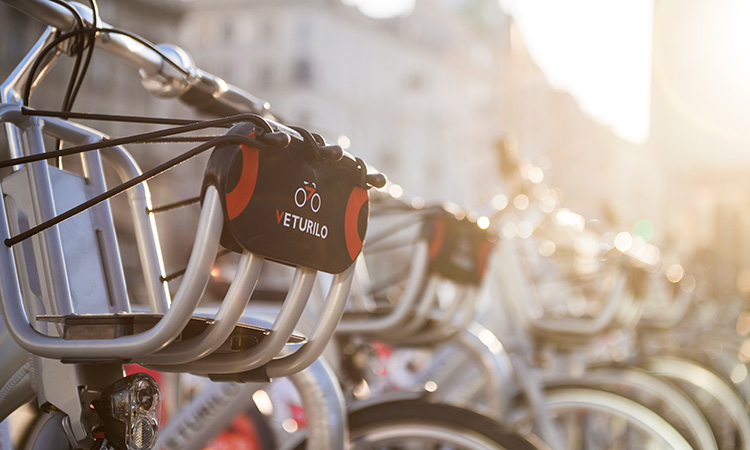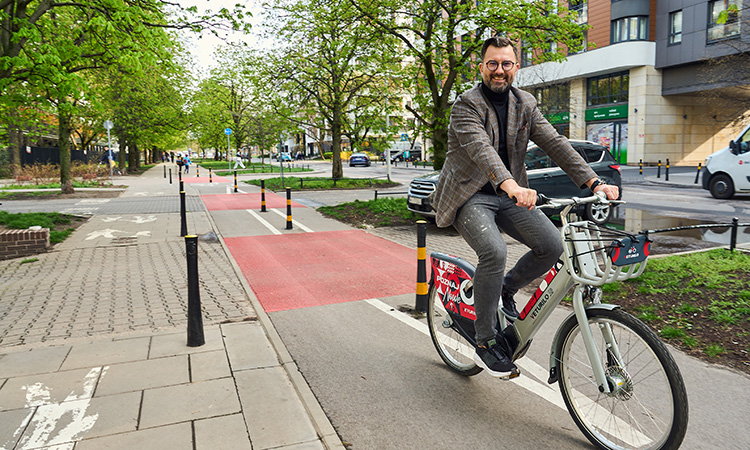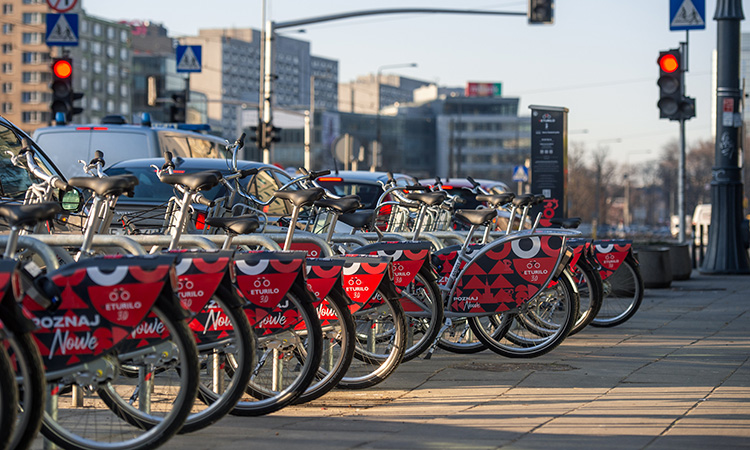CEE micro-mobility is catching the waves: Opportunities and challenges in 2024
- Like
- Digg
- Del
- Tumblr
- VKontakte
- Buffer
- Love This
- Odnoklassniki
- Meneame
- Blogger
- Amazon
- Yahoo Mail
- Gmail
- AOL
- Newsvine
- HackerNews
- Evernote
- MySpace
- Mail.ru
- Viadeo
- Line
- Comments
- Yummly
- SMS
- Viber
- Telegram
- Subscribe
- Skype
- Facebook Messenger
- Kakao
- LiveJournal
- Yammer
- Edgar
- Fintel
- Mix
- Instapaper
- Copy Link
Posted: 22 February 2024 | Tomasz Wojtkiewicz - Nextbike Poland | No comments yet
The past year has been exceptionally intense for the micro-mobility market. From the renaissance of Mobility-as-a-Service, through EU funds for local government units, to combatting transport divide, Tomasz Wojtkiewicz, CEO of Nextbike Poland, explores some of the key challenges and opportunities that have the potential to transform the whole of Central and Eastern Europe (CEE) public transportation and cities themselves.


Credit: Nextbike Poland
At first glance, the recently announced bankruptcy of Bird, a pioneer in the field of shared e-scooters, might seem like a nail in the coffin for urban micro-mobility. However, this is merely an illusion created by New Year’s prophets seeking temporary applause. As far back as the 2nd century AD, Artemidorus of Daldis, an ancient author of dream interpretation guides, recommended using the services of fortune tellers but warned against charlatans, emphasising the value of trusting only experienced specialists. According to them, shared mobility will fare quite well.
The number of shared scooters worldwide is expected to increase at a rate of 13.4%… from 1.6 million at the end of 2022 to three million by 2027″
Companies offering shared scooters and bicycles are becoming increasingly integral to urban life. The Research and Markets report estimates that, globally, the number of bicycles in sharing systems could increase from 23 million at the end of 2022 to as much as 35 million by 2027, with over 70% of this market being in Asia, led by China. The number of shared scooters worldwide is expected to increase at a rate of 13.4% during the same period, from 1.6 million at the end of 2022 to three million by 2027. From this data, it is clear that micro-mobility continues to evolve, with bicycles still forming its core. While scooters are still perceived as an interesting recreational option, bicycles play a significant role in users’ consciousness as a complement to traditional public transportation for first- and last-mile journeys.
According to NACTO research, an American organisation representing officials in urban transportation, over 34% of users utilise micro-mobility solutions to commute to work, 39% to run various errands and 16% to travel to school. In addition, 50% of respondents declare the use of micro-mobility for other purposes, including recreation. Ahead of us are local elections and European Union (EU) subsidies under the National Recovery Plan, which envisage support for low-emission transport. Therefore, the globally visible trend of micro-mobility development will certainly not bypass Central and Eastern Europe (CEE). The year 2024 thus presents a huge opportunity for micro-mobility to firmly strengthen its significance but, at the same time, there will be a range of opportunities to seize and challenges to overcome.
The renaissance of Mobility-as-a-Service
‘Metrobike’ will be equivalent to a bus, tram or trolleybus, and individuals with season tickets for public transportation will be able to use the Metrobike for free for 60 minutes each day”
In recent years, there has been increasing attention to the need for the development of multimodal public transportation, which extends beyond just trains and buses. Across Europe, the importance of Mobility-as-a-Service (MaaS) is growing, represented by transportation super apps, where users can book and pay for taxis, rent cars, buy train tickets or rent bicycles and scooters through a single channel. The latest research by Juniper regarding mobility predicts that the number of integrated MaaS users will increase by 326% by 2028.
The concept of MaaS is crucial for realising the idea of smart cities, and such an approach to public transportation is already being implemented in Asia, as well as closer to us in Sweden, the Netherlands and Belgium. In Poland, an example of the beginning of this trend could be the project of the Upper Silesian-Zagłębie Metropolis, in which the traditional means of public transportation will be supplemented by the Nextbike bicycle system. The so-called ‘Metrobike’ will be equivalent to a bus, tram or trolleybus, and individuals with season tickets for public transportation will be able to use the Metrobike for free for 60 minutes each day.


Credit: Nextbike Poland
The development of mobility centres
In tandem with the development of MaaS in 2024, the continued growth of multimodal centres will be seen – physical areas where residents can access various transportation options, centred around existing train stations or taxi stands. As connectivity increases, especially in the era of smart cities, mobility centres will become crucial in the development of urban transportation. This solution will also be significant in terms of reducing transport exclusion. Through local development of micro-mobility services, railway stations and bus stops can naturally evolve into municipal bike-and-ride transport hubs.
Social challenges: Ecology and transport divide
Shared micro-mobility may prove to be a key tool in achieving the climate goals of CEE cities and developing highly accessible public transportation in 2024. In the first case, even a small change in transportation habits can be beneficial for cities.
It is the responsibility of decision-makers today to ensure accessible public transportation for every resident, promoting sustainable mobility”
Recent McKinsey analysis explored what would happen if residents of a hypothetical metropolitan area, with a population of about 1.1 million and about 370 km2 of occupied space, used bicycles for 22.5% of the kilometres that they now travel by private car. Assuming that travellers switch from private cars to bicycles for 22.5% of the kilometres travelled, the size of the car park would drop from about 520,000 vehicles to around 400,000, reducing emissions. After factoring in the emissions associated with bicycle manufacture, we estimated that the total annual emissions would fall by about 500 tonnes in this hypothetical city. This reduction is equivalent to the annual emissions generated by approximately 71,000 Europeans, which represents about 7% of the city’s population.
The second issue, which is transport divide, is very important in terms of social expectation. According to EU reports, 2.4% of all people in the EU and 5.8% of those at risk of poverty cannot afford to use public transport regularly. Besides cost, access to transport depends on other factors, including the quality and frequency of services, the state of the infrastructure and accessibility (both digital and physical).
Many cities in Poland and other Eastern countries of former Communist Bloc have long faced the problem of transport exclusion. Many localities, and often neighbourhoods located in seemingly well-connected metropolises, lack adequate transportation, making it difficult for people to commute to schools or work. For example, in Poland, the problem may affect up to 14 million Poles, and more than 20% of towns in Poland do not have any public transport reaching them. Thus, it is the responsibility of decision-makers today to ensure accessible public transportation for every resident, promoting sustainable mobility. As local PBS research agency indicates, over 80% of Poles expect an increase in the number of connections within public transportation in their area, and one-third declare a willingness to give up their own car in favour of well-functioning public transportation.


Credit: Nextbike Poland
European Union funding for micro-mobility
EU funds are crucial for the development of micro-mobility in Europe, and an enhancement of this trend is expected in 2024″
CEE cities, in order to maintain the benefits associated with urban ecology and the development of public transportation, will seek partners in the field of micro-mobility or extend existing contracts. However, the inflationary reality and limited budgets will push them even more strongly than before to seek additional sources of funding. EU funds are crucial for the development of micro-mobility in Europe, and an enhancement of this trend is expected in 2024.
The European Union has numerous financial programmes that support sustainable transport, including micro-mobility. For example, innovation programmes like Horizon Europe or regional programmes such as the Cohesion Fund. For many Eastern Europe local governments, it may also be crucial to use the RePowerEU programme, which is part of the EU’s plan of fostering energy transformation and lowering independence from Russian fossil fuels. These funds will not only be allocated for the development of renewable energy sources and green energy for Poles, but also for zero-emission transport, which could significantly accelerate the development of Polish urban micro-mobility.
Better utilisation of big data and artificial intelligence
We have been utilising and developing chatbot solutions for user support for the past two years”
In the field of micro-mobility, an increasing amount of data is being collected and analysed, enabling operators to compare factors such as availability, incident or vandalism notifications, as well as energy parameters, efficiency, return speed and application stability. This wealth of data will, in turn, help to effectively optimise actions from both a business, consumer and climate perspective. Incorporating artificial intelligence (AI) solutions into this process can further strengthen competencies in this area, and even in the realm of customer experience.
AI is already being used worldwide, for example, to combat improper scooter parking, which has improved not only the scooter system but also positively impacted the functioning of the entire urban micro-mobility system, including bicycles, as seen in Chicago. At Nextbike, we have been utilising and developing chatbot solutions for user support for the past two years. The data-driven approach has been ingrained in our brand’s DNA for many years. In the past year, through comprehensive analysis, we have developed a new bike servicing model, with over 70% of activities being carried out directly on the streets. This increases bike availability, system efficiency and also contributes to the reduction of our own CO2 emissions.


Related topics
Accessibility, Active travel, Micro-mobility, Mobility Services, Passenger Experience, Public Transport, Sustainable Urban Transport
Related modes
Bikes & Scooters, Bus & Coach, Taxi
Related countries
Belgium, China, Poland, Sweden, The Netherlands, United States
Related organisations
Nextbike Poland
Related people
Tomasz Wojtkiewicz








